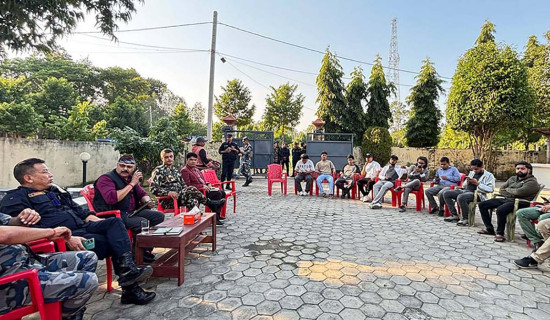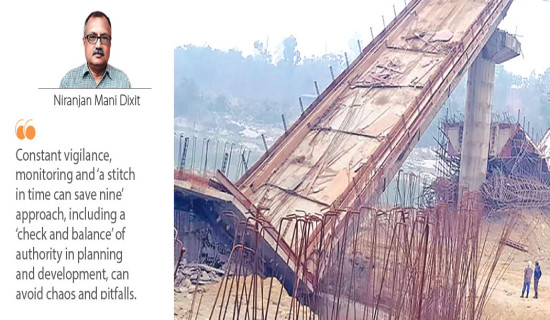- Saturday, 22 November 2025
Tackling Climate Impact On Mountains
Mountain regions are an important part of the world. Around ten per cent of the world population lives in the mountain regions. Most of the mountain people live in developing countries. The mountain regions are home to half of the global biodiversity. Mountains are a source of fresh water. Many rivers originate from mountains. Half of the global population depends on mountains for fresh water. All this goes on to vindicate the importance of mountains in the livelihoods of people.
Despite the immense contributions of mountains to maintaining ecosystems and biodiversity, those living in the mountain regions are forced to live in harsh conditions. Mountain regions are home to some of the poor and vulnerable groups of people. They are poor not only from an economic point of view but also from a political standpoint. They are the people who have the least say in decision-making at the political level. Climate change is affecting the world as a whole. Its impacts are everywhere to be seen. Climate change affects irrigation, hydropower development, urbanisation, industrialisation and other sectors. Even the human health may be affected. The mountain regions are experiencing the impacts more than any part of the world.
Shrinking glaciers
As such, glaciers are shrinking, the supply of water is diminishing, soil erosion is increasing and natural disasters like floods, landslides and avalanches are increasing. Without a doubt, these undesirable events are due to rising temperatures induced by global warming. It is reported that temperatures are rising faster at higher altitudes than in other parts of the world. Fear of glacier bursts or glacier lake outburst floods (GLOFs) has been amplified by climate change. Recent research has shown that Mt. Everest glaciers have lost 2,000 years of ice in the past 30 years and that Himalayan glaciers have disappeared 65 per cent faster since 2010 than in the previous decades.
Mountain communities contribute very little to greenhouse gas emissions but they have to bear the brunt of the impacts of climate change for no fault of theirs. Ever-burgeoning greenhouse gas emissions are ruining their livelihoods and playing havoc with the mountain ecosystems. The mountain regions are prone to multiple hazards. Such hazards are exacerbated by climate change. Storms, landslides, avalanches and rock falls are some of the extreme hazards engendered by climate change.
The impacts of climate change have attracted the attention of the world that is struggling to mitigate such effects. With climate change affecting various sectors, world leaders have made deliberations on how to mitigate its impacts. They have accordingly prepared mitigation and adaptation strategies. They have also formulated various conventions on mitigating the impacts of climate change. The impacts of climate change have already manifested themselves in the mountain regions such as the Himalayan range. It is difficult to reverse such impacts. For example, when ice melts on a very large scale, it is well-nigh impossible to put it back to the frozen state.
On one hand, people living in the mountain regions are already leading a harsh life, while climate change has worsened their livelihoods, on the other. So the world leaders should pay adequate attention to their woes as their voices often go unheard. The mountain regions are a trove of biodiversity. Farming of various crops and rearing of livestock are carried out there. The mountain people are rich in traditional knowledge and farming practices that should be encapsulated in the adaptation strategies formulated by the world leaders.
It may be noted that local varieties of crops should be protected at any cost. These varieties are hardier and better than modern, introduced varieties. Planting a variety of crops is essential to avoid crop failure in harsh climatic conditions. Crop failure may lead to widespread famine and poverty in the mountain regions. So the adaptation strategies should incorporate the traditional knowledge and practices of the mountain people. The mountain people are experiencing drastic changes in food and farming systems owing to climate change. Their traditional knowledge, cultural values and languages should be integrated into education systems so as to perpetuate them.
Adaptation strategies
Besides, their rights to land, natural resources and traditional ways of life should be recognised and incorporated in the mitigation and adaptation strategies. Further, the UN Declaration on the Right to Indigenous Peoples should be fully translated into action. The mountain people are rarely provided with support – financial or otherwise. Therefore, they should be given benefits through the climate finance allocation plan. Without such support, their life may further worsen. And the mountain ecosystems and biodiversity may also take a knock. While formulating mitigation and adaptation strategies for the mountain regions, the mountain people should be allowed to participate in planning.
They have indigenous knowledge and skills. They know how to adapt themselves to harsh conditions. Including their knowledge and skills in such mitigation and adaptation strategies will be more effective. There is not even an iota of doubt that mountains are the natural heritage of the world. Conserving them is a must from the viewpoint of maintaining ecosystems and biodiversity. The mountain people should be allowed to enjoy tangible benefits from conservation efforts. Conserving the mountain regions through formulating participatory strategies designed to mitigate the impacts of climate change and enable the mountain people to better adapt themselves to climate change are a must in the present-day context.
(Maharjan has been regularly writing on contemporary issues for this daily since 2000.)

















